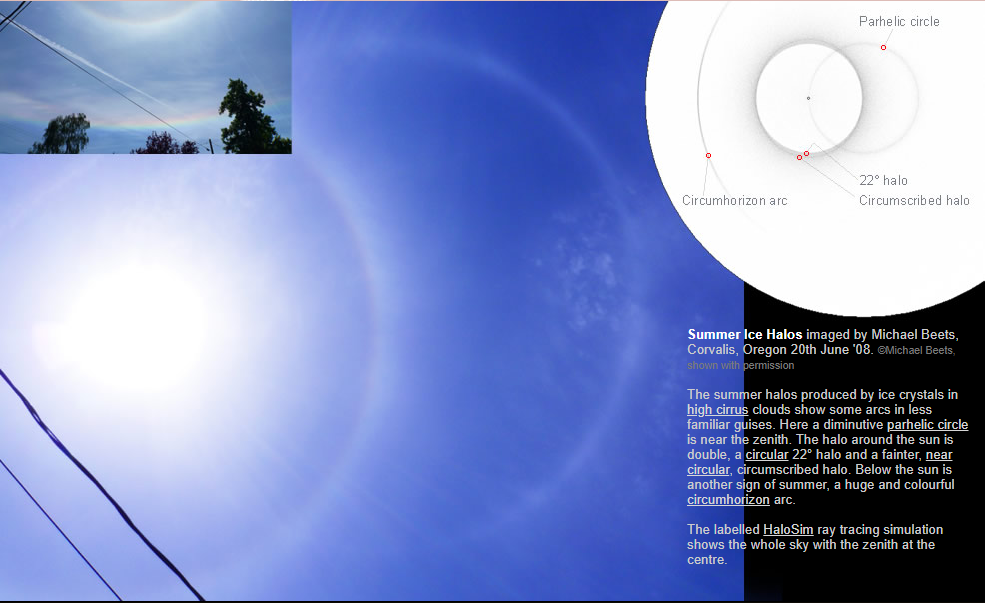Summer Ice
Summer Ice: A Closer Look at Atmospheric Optics
Have you ever looked up at the sky on a summer day and noticed peculiar optical phenomena? The presence of ice crystals in high cirrus clouds can give rise to fascinating displays of light known as summer ice halos. While we may be familiar with the more common halos, such as the circular 22° halo around the sun, summer ice halos can exhibit arcs in less familiar guises, adding an element of intrigue to the spectacle above us.
One remarkable example of a summer ice halo is the diminutive parhelic circle, which can be observed near the zenith. This circle appears as a faint, circular band of light encircling the point directly overhead. It is formed by sunlight passing through horizontally oriented ice crystals, resulting in the scattering and redirection of light rays. The parhelic circle serves as a captivating reminder of the complex interplay between light and ice crystals in the atmosphere.
Another captivating feature of summer ice halos is the double halo that surrounds the sun. This halo consists of a prominent circular 22° halo and a fainter, near-circular circumscribed halo. The 22° halo is formed by the refraction and reflection of sunlight within hexagonal ice crystals, resulting in the creation of a ring of light at an angle of approximately 22 degrees from the sun. The circumscribed halo, on the other hand, is produced by sunlight passing through horizontally oriented ice crystals, similar to the parhelic circle.
But the wonders of summer ice halos do not end there. Below the sun, one can often witness the presence of a huge and colorful circumhorizon arc. This arc appears as a vivid band of colors stretching horizontally across the sky. It is caused by sunlight interacting with plate-shaped ice crystals suspended in the atmosphere. When sunlight enters these ice crystals at a specific angle, it undergoes refraction and dispersion, resulting in the separation of colors and the creation of this captivating arc.
The complexity and variety of summer ice halos can be further appreciated through ray tracing simulations. These simulations provide a visual representation of the entire sky, with the zenith at the center. By tracing the paths of light rays through various ice crystal configurations, scientists and enthusiasts can gain insights into the intricate mechanisms behind the formation of these optical phenomena. Such simulations help deepen our understanding of the interplay between sunlight and ice crystals, shedding light on the captivating world of atmospheric optics.
In conclusion, summer ice halos offer a captivating glimpse into the wonders of atmospheric optics. From the diminutive parhelic circle near the zenith to the double halo surrounding the sun, these optical phenomena showcase the intricate interplay between sunlight and ice crystals in high cirrus clouds. The presence of a colorful circumhorizon arc below the sun adds to the visual spectacle, creating a truly mesmerizing experience. Through ray tracing simulations, scientists continue to unravel the complexities of these phenomena, deepening our understanding of the natural world above us. So, next time you find yourself gazing at the summer sky, take a moment to appreciate the intricate beauty that lies within summer ice halos.

Summer Ice Halos imaged by Michael Beets, Corvalis, Oregon 20th June '08. ©Michael Beets, shown with permission.
The summer halos produced by ice crystals in high cirrus clouds show some arcs in less familiar guises. Here a diminutive parhelic circle is near the zenith. The halo around the sun is double, a circular 22° halo and a fainter, near circular, circumscribed halo. Below the sun is another sign of summer, a huge and colourful circumhorizon arc.
The labelled HaloSim ray tracing simulation shows the whole sky with the zenith at the centre.
Note: this article has been automatically converted from the old site and may not appear as intended. You can find the original article here.
Reference Atmospheric Optics
If you use any of the definitions, information, or data presented on Atmospheric Optics, please copy the link or reference below to properly credit us as the reference source. Thank you!
-
<a href="https://atoptics.co.uk/blog/summer-ice/">Summer Ice</a>
-
"Summer Ice". Atmospheric Optics. Accessed on November 26, 2024. https://atoptics.co.uk/blog/summer-ice/.
-
"Summer Ice". Atmospheric Optics, https://atoptics.co.uk/blog/summer-ice/. Accessed 26 November, 2024
-
Summer Ice. Atmospheric Optics. Retrieved from https://atoptics.co.uk/blog/summer-ice/.